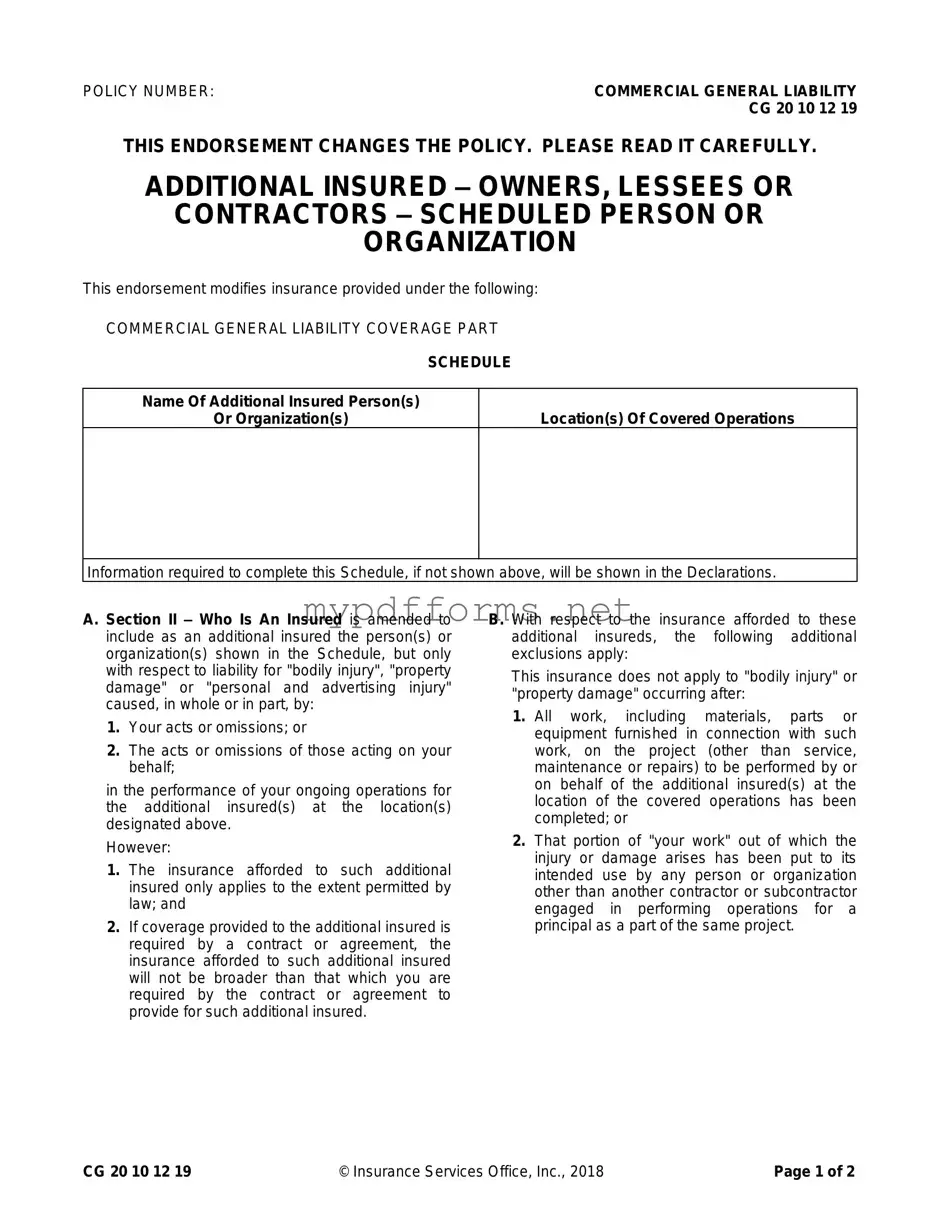The CG 20 10 07 04 Liability Endorsement form is similar to the CG 20 10 12 19, which is another endorsement that adds additional insureds to a commercial general liability policy. Like the CG 20 10 07 04, it provides coverage for additional insureds with respect to liability for bodily injury, property damage, or personal and advertising injury. Both forms specify that the coverage applies only to the extent of the named insured's acts or omissions and are subject to the same limitations regarding contractual obligations. The key difference lies in the specific conditions and exclusions that may vary between the two endorsements, but the fundamental purpose remains consistent: to extend liability coverage to additional parties involved in a project.
The CG 20 37 10 01 is another endorsement that shares similarities with the CG 20 10 07 04. This endorsement is designed to provide coverage for additional insureds when the named insured is required to do so by a contract. It outlines the scope of coverage, emphasizing that it does not exceed what the contract stipulates. Like the CG 20 10 07 04, it includes exclusions that limit coverage based on the completion of work. Both documents aim to clarify the extent of liability coverage for additional insureds, ensuring that the named insured's obligations are met without exceeding the agreed-upon limits.
The CG 20 10 11 01 endorsement is also relevant as it modifies the insurance policy to include additional insureds. This form specifically addresses coverage for liability arising from the ongoing operations of the named insured. It shares the same core elements as the CG 20 10 07 04, focusing on bodily injury and property damage. Both endorsements limit coverage based on the completion of work and the contractual obligations of the named insured. The CG 20 10 11 01 provides additional clarity on the scope of coverage, making it an essential document for contractors and subcontractors working under specific agreements.
The CG 20 10 03 01 endorsement is another document that parallels the CG 20 10 07 04. This endorsement adds coverage for additional insureds but specifically focuses on completed operations. It is similar in that it provides coverage for bodily injury and property damage arising from the named insured’s work. However, it emphasizes that coverage applies only after the work has been completed, which differs from the ongoing operations focus of the CG 20 10 07 04. Both forms are critical for ensuring that additional insureds have the necessary protection, but they cater to different phases of a project.
The CG 20 10 02 01 endorsement also bears resemblance to the CG 20 10 07 04. This form is used to add additional insureds but focuses on specific locations or projects. Like the CG 20 10 07 04, it provides coverage for bodily injury and property damage but emphasizes the need for proper documentation of the insured locations. Both endorsements ensure that additional insureds are protected under the commercial general liability policy, but the CG 20 10 02 01 adds a layer of specificity regarding where coverage applies.
When dealing with the sale of a motor vehicle in Illinois, it’s crucial to have the appropriate documentation in place to ensure a smooth transaction. The Illinois Motor Vehicle Bill of Sale form serves as a key legal document that confirms the agreement between the seller and buyer. For more detailed information and resources, you can visit Illinois Forms, which provides access to the necessary forms and guidance needed for completing the sale properly.
Lastly, the CG 20 10 04 01 endorsement is similar in that it also addresses additional insureds in the context of liability coverage. This form is particularly focused on liability arising from the actions of subcontractors. Like the CG 20 10 07 04, it specifies the conditions under which the additional insureds are covered, including the requirement for the named insured's acts or omissions. Both endorsements aim to protect additional parties involved in a project, ensuring that liability coverage extends appropriately while adhering to contractual obligations.
